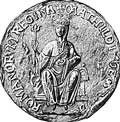 |
Matildab. c. 7 Feb 1102, Sutton Courtenay, Berkshire, England |
| Title: | Anglorum Domina (Lady of the English) [1] |
| Term: | 8 Apr 1141 - Feb 1148 |
| Chronology: | 3 Mar 1141, proclaimed Lady of the English, ceremony at the Winchester Cathedral |
| 8 Apr 1141, a clerical council at Winchester confirmed Matilda as Lady of the English | |
| Feb 1148, departed from England | |
| Names/titles: | Also known as: Maud, Mold, Aethelic, Aaliz (last two forms appear in the "English Chronicle" and in the works of John of Hexham); Imperatrix (Empress) [2]; Romanorum Regina (Queen of the Romans) [from 25 Jul 1110] |
| Biography: | |
The only daughter of King Henry I and Edith (Matilda) of Scotland, Matilda was formally betrothed to Heinrich V, King of the Germans, at Utrecht on 10 Apr 1110. She was crowned Queen of the Germans at Mainz (25 Jul 1110) and their marriage was celebrated at Worms on 6 Jan 1114. After the death of Heinrich V (23 May 1125), she was recalled to her father's court, who obtained of the English baronage an oath to accept Matilda as sovereign if he should die without a male heir (January 1127). On 8 Jun 1129 Matilda was married to the heir of Anjou, Maine, and Touraine, Geoffroi "Plantagenêt" (future count of Anjou). Matilda opposed her cousin, Stephen of Blois, who seized the throne of England after the death of Matilda's father (1135), and in 1139 she and her illegitimate half-brother, Robert earl of Gloucester, landed in England. In an ensuing war with Stephen the latter was captured after a battle at Lincoln (2 Feb 1141). Stephen's brother, Henry of Blois, bishop of Winchester and papal legate, transferred his support from Stephen to Matilda and on 2 Mar 1141 he received Matilda as "Lady of the English" or "Lady of England" outside the gates of Winchester. The following day, 3 Mar 1141, Matilda was publicly welcomed in Winchester Cathedral and received the keys to the Treasury and the Royal Crown. The legate then summoned a "legatine church council", which met on 7 Apr 1141 and on the next day proclaimed Matilda "Angliae Normanniaeque domina". She entered London in June 1141, but alienated its citizens with her arrogance and demands for a large subsidy. A sudden uprising of the city forced her to flee to Oxford before she could be crowned. Her forces were routed at Winchester in September 1141, and Robert of Gloucester was captured by the forces of Stephen. Matilda was obliged to swap Stephen for Robert (1 Nov 1141) and the warfare continued. In 1148, after the death of Robert (31 Oct 1147), Matilda finally returned to Normandy. Late in 1150 her son, Henry (future King Henry II), was put in possession of the duchy of Normandy and replaced his mother as claimant to the throne of England. [3; 4] |
|
| | |
| [1] | Consequent upon a ceremony of election (8 Apr 1141), Matilda styled herself "Anglorum domina" in charters and writs ("Mathildis Imperatrix Henrici regis filia et Anglorum domina", "Mathildis Imperatrix Henrici Regis filia"), but continued to use a personal seal bearing the legend MATHILDIS DEI GRACIA ROMANORUM REGINA. There is no sound evidence that she called herself "regina Angliae" as suggested by a seal, which before it was destroyed was described as reading MATHILDIS IMPERATRIX ET REGINA ANGLIAE. A charter, in which she is styled "regina Anglorum" exists only in copies and probably emerged as a result of an error made by a scribe "correcting" "domina Anglorum". Between 1151 and 1153 Matilda and her son jointly issued charters as "Mathildis imperatrix Henrici regis filia et Henricus eius filius dux Normannorum" with "et comes Andegavorum" added in one case. |
| [2] | In 1117 Matilda participated in one or two ceremonies of the crown-wearing in Rome, but she was never crowned as empress by the pope. After the death of her husband, Heinrich V, she styled herself "imperatrix". It became widely recognized, at least as a courtesy title and was used until the end of her life. |
| [3] | Handbook of British Chronology (1986) |
| [4] | "The Empress Matilda: Queen Consort, Queen Mother and Lady of the English", by Marjorie Chibnall (Blackwell, Oxford, 1991). |
| Image: Great Seal of Matilda with the inscription MATHILDIS DEI GRACIA ROMANORUM REGINA. | |
